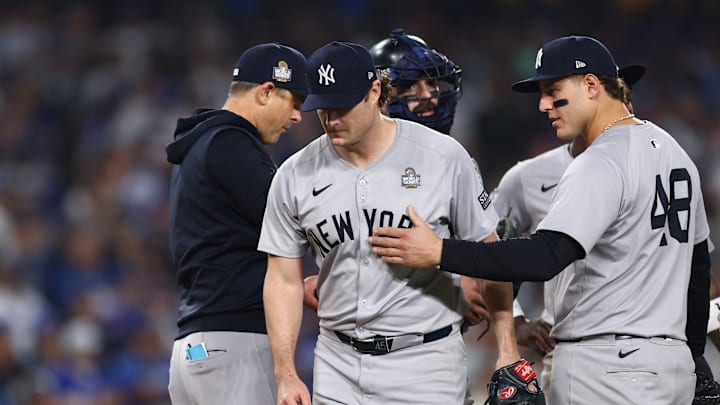The Yankees are paying Gerrit Cole 324 million dollars to be the best pitcher on the planet, but in Game 1 of the World Series, they acted like he was an unproven rookie. Cole was making quick work of the Dodgers in the early going, but ran into turbulence in the seventh inning. Teoscar Hernández led off with an eight-pitch at-bat, culminating in a single, and it was curtains for Cole. The Yankees would go on to lose the game in extra innings.
For most of baseball history, conventional wisdom dictated sticking with your ‘ace’ for as long as possible. Then, about 20 years ago, the paradigm started to shift, and now the sport is experiencing an over-correction. Managers are more data-driven in their decision-making, and pitchers tend to lose effectiveness the second and third time through a lineup or when they have higher pitch counts. However, that doesn't mean taking your best pitcher out of the game is a good idea when he's dominating.
And Cole was dominating. He had not topped 15 pitches in any inning, leaving the game after only 88 pitches, 41 pitches fewer than his career high. The only run the Dodgers scored came when Juan Soto misplayed a Kiké Hernandez line-drive in right field, allowing Hernandez to go to third and score on a sacrifice fly. Before the single, Cole retired Ohtani, Betts, and Freeman for the third time, and he had the same velocity on his fastball that he did in the first inning. Cole's slider and curveball were elite, garnering a massive 46% Called Strikes + Whiffs (CSW) with the slider and 27% CSW with the curveball. When Max Muncy, the hitter due up at the plate, saw Aaron Boone move to take Cole out of the game, he must have breathed a sigh of relief.
Removing Cole in the sixth inning during the regular season wouldn't be an issue; it's a 162-game marathon. But when the calendar turns to October, it's a sprint. Regardless of what the averages are, how a pitcher usually performs over the long run, or whatever the data says doesn't matter. It's mitigated because there's a new set of data that's more important: "how is my guy doing tonight?".
Don't lose the forest for the trees. Cole wasn't losing velocity and he wasn't missing his spots. Teoscar Hernandez had a good at-bat (he's a good hitter), and he had good at-bats all night against Cole. If you're the Yankees, you must ask yourself why Gerrit Cole has the same leash as Carlos Rodón or Clarke Schmidt. Isn't the 'ace' the pitcher you want on the mound over any other pitcher on the team, except maybe the closer? In October, when you take a pitcher out of the game, you're not saving his arm for the rest of the season; you're saying this reliever has a better chance to get outs than the guy he is replacing.
The immediate effect is whoever you replace him with might not have their best stuff that night. You go from a known to an unknown. Even if you manage to get out of the inning, the other team gets more looks at your high-leverage relievers, and the more looks guys get at relievers, the easier they are to hit, no matter how good they are.
You should need a good reason for taking out your ace, not just because that's what you would have done in a random game in July. Boone and the Yankees are paying the price for it now, down 3-0 in the World Series.
